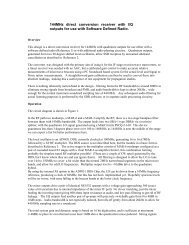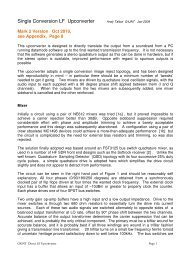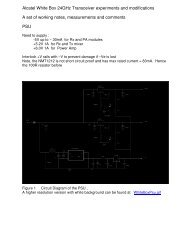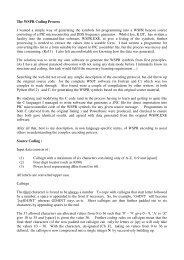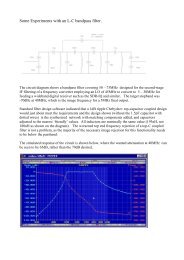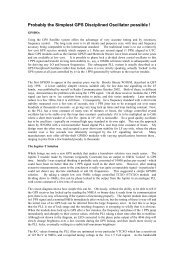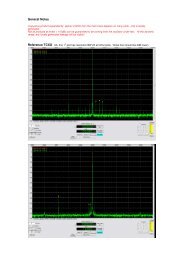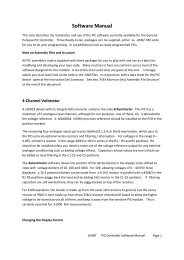JT4 Data on the UKµWG Reverse DDS Module - G4JNT
JT4 Data on the UKµWG Reverse DDS Module - G4JNT
JT4 Data on the UKµWG Reverse DDS Module - G4JNT
You also want an ePaper? Increase the reach of your titles
YUMPU automatically turns print PDFs into web optimized ePapers that Google loves.
Freq<str<strong>on</strong>g>Data</str<strong>on</strong>g> is a label signifying <strong>the</strong> start of <strong>the</strong> frequency data, and MUST occur at <strong>the</strong> extreme leftof <strong>the</strong> .INC file.The next 8 lines (starting de to signify <strong>the</strong>y are EEPROM data) each c<strong>on</strong>tain <strong>the</strong> 32 bits (4bytes) of frequency informati<strong>on</strong> for <strong>the</strong> eight pre-stored frequencies, corresp<strong>on</strong>ding to t<strong>on</strong>es 0 – 7,most significant byte first. Although shown in Hex, it is permissible to list <strong>the</strong>se in decimal notati<strong>on</strong>if this is preferred for calculati<strong>on</strong> purposes. The first four lines are <strong>the</strong> frequencies of each of <strong>the</strong><str<strong>on</strong>g>JT4</str<strong>on</strong>g> symbols. The next four are t<strong>on</strong>es that can be selected by <strong>the</strong> user to give, for example, areference at exactly <strong>the</strong> mid point in <strong>the</strong> spectrum (t<strong>on</strong>e 1.5) or a pair of precisely spaced t<strong>on</strong>es forCW keying. Which t<strong>on</strong>e is allocated to which functi<strong>on</strong> is defined in <strong>the</strong> secti<strong>on</strong> above, and it is noteven necessary to calculate any values for frequencies 4 – 7 if all keying uses <strong>the</strong> <str<strong>on</strong>g>JT4</str<strong>on</strong>g> t<strong>on</strong>es. Inthis case programme a value of zero into <strong>the</strong> unused spaces. The programming frequencygenerati<strong>on</strong> utility <str<strong>on</strong>g>JT4</str<strong>on</strong>g>_<strong>DDS</strong>_Freqs.EXE gives <strong>the</strong> opti<strong>on</strong> of copy-and-pasting directly into <strong>the</strong>.INClude file. Highlight <strong>the</strong> generated frequency data <strong>the</strong>n copy and paste directly underneath<strong>the</strong> Freq<str<strong>on</strong>g>Data</str<strong>on</strong>g> label, deleting old data and adding comments as appropriate.CWMsg is a label to show that this line is EEPROM data c<strong>on</strong>taining <strong>the</strong> CW message insideinverted commas. It can be of arbitrary length and <strong>the</strong>re is space for about 40 characters. Thedata must have a zero, a null terminator, after <strong>the</strong> closing inverted commas exactly as shown toindicate <strong>the</strong> end of <strong>the</strong> message. If not present, <strong>the</strong> software will crash! If <strong>the</strong> CW message is tool<strong>on</strong>g <strong>the</strong> compiler will generate an error message about data being overwritten.The final line, C<strong>on</strong>trolPLL is a flag to indicate whe<strong>the</strong>r <strong>the</strong> <strong>DDS</strong> clock X6 multiplier is to be used.For R<strong>DDS</strong> c<strong>on</strong>figurati<strong>on</strong> it must be set to 0 - PLL disabled. When this PIC code used with astandal<strong>on</strong>e source, <strong>the</strong> PLL may be enabled.<str<strong>on</strong>g>JT4</str<strong>on</strong>g>SYMBS.INCThis include file is generated automatically in exactly <strong>the</strong> form shown as a result of running <strong>the</strong>utility GEN<str<strong>on</strong>g>JT4</str<strong>on</strong>g>.EXE. [3] It should not be necessary to alter <strong>the</strong> file in any way. As <strong>the</strong> file isregenerated and overwritten each time GEN<str<strong>on</strong>g>JT4</str<strong>on</strong>g> is run, it is advisable to save a copy under adifferent name – eg, GB3SCS_<str<strong>on</strong>g>JT4</str<strong>on</strong>g>SYMBS.INC.The WSJT software does offer <strong>the</strong> ability to generate <strong>the</strong> symbol data in a listed form, and usersmay want to use this route instead – for example to include a ‘QSO-type’ message into <strong>the</strong>beac<strong>on</strong> data instead of 13 characters of plain text. In this case, <strong>the</strong> individual symbol data in <strong>the</strong>form of 207 numbers with values 0 – 3 will have to be assembled manually into <strong>the</strong> EE databytes, four-at-a-time starting with <strong>the</strong> most significant pair of bits. For example, if <strong>the</strong> first eightsymbols generated are 3,1,2,0,2,1,3,0, <strong>the</strong> resulting first two bytes will be b’11011000’ andb’10011100’ or in hex 0xD8, 0xC0. Both <strong>the</strong>se formats, binary or hex, (or even decimal as d’nn’) are acceptable to <strong>the</strong> compiler. Read <strong>the</strong> WSJT documentati<strong>on</strong> for fur<strong>the</strong>r details of how togenerate <strong>the</strong> symbol list.<str<strong>on</strong>g>JT4</str<strong>on</strong>g> for R<strong>DDS</strong> <strong>Module</strong> <strong>G4JNT</strong> Page 6



